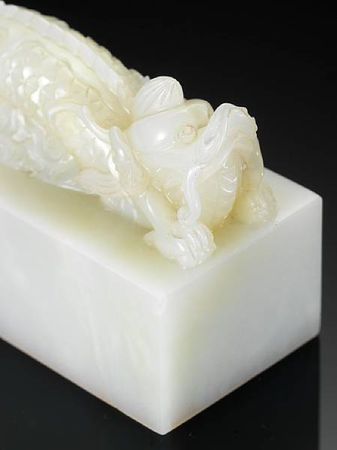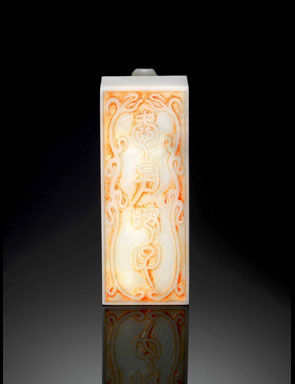Imperial White Jade Double-Dragon Seal for Sale at Bonhams
The short reign of the Guangxu Emperor was witness to one of the most disruptive periods in the dynasty.
LONDON.- The wise words – ‘Love your people as you would your own children’ - on the seal of a Chinese Emperor who ruled a century ago were not enough to save his reign during the Boxer Rebellion around 1900.
The Imperial white jade double-dragon seal is estimated to sell for £100,000 to £150,000 at Bonhams sale of Fine Chinese Art in New Bond Street on 5th November during Asian Art week in London.
Asaph Hyman, Senior Specialist in Chinese Art at Bonhams, comments: “Once in a while an object of unique Imperial Chinese importance emerges which causes one to catch one’s breath, holding in one’s hands a personal object used by an Emperor that exceptionally captures his love for his people as shown in his attempt at reform. It is a great privilege to be selling such an extraordinary, fine and rare seal.”
The use of such a benevolent message on his seal seems appropriate for the young ruler of a country determined to introduce reform presented by Imperial initiative. But such benevolence was in vain.
The short reign of the Guangxu Emperor was witness to one of the most disruptive periods in the dynasty. Increased and intensified imperialist expansion led to the growth of the nationalist group, Boxers United in Righteousness, who by 1900 were openly attacking, and sometimes killing, Chinese converts and those who possessed foreign objects, as well as foreigners themselves. This attack came to a climax at the siege of the Legations.
In retaliation, on August 4, 1900, 20,000 foreign troops marched on Beijing, leading the Guangxu Emperor and the Dowager Empress Cixi to flee to Xi'an, where they would stay until 1902. The era of disruption continued onto the short reign period of the Xuantong Emperor, more commonly known as Pu Yi, a time in which Imperial treasures were sold to finance the expenses of the Court or stolen by Eunuchs working in the Forbidden City.
The rectangular seal is surmounted with a pair of dragons, each recumbent with bulging eyes and a scaly conjoined body arching over swirling clouds pierced with an aperture for attachment, the base carved with four characters reading 'Airen Ruzi' within a border of scrolling tendrils, the stone of a pale white tone with small areas of opaque inclusions. It is just four and a quarter inches long.
The seal has been identified as being in the personal use of the Guangxu Emperor. The four-character 'Ai Min Ru Zi' inscription can be translated as 'Love your people as you would your own children'. These four characters have been identified by Guo Fuxiang, Researcher at the Department of the Palace History, The Palace Museum, Beijing, as one of the personal impressions used by the Guangxu Emperor. This Seal impression is listed among the twenty-eight Guangxu Imperial seals held in the Imperial collection in the Forbidden City.
Imperial seals belonging to the Guangxu Emperor are rare. Some have been identified as having belonged to the Guangxu Emperor and the Dowager Empress Cixi, and are believed to have been looted in 1900 during the Boxer Rebellion.
The Emperor Guangxu reigned from 1874 – 1908 dying in mysterious circumstances at the age of 37. In practice he ruled, under Dowager Empress Cixi's influence. He initiated the Hundred Days' Reform, but was abruptly stopped when Cixi launched a coup in 1898, after which he was put under house arrest until his death.
In 1900, the Eight-Nation Alliance of Western powers and Japan entered China and on August 14, occupied Beijing following a Chinese declaration of war which the Guangxu Emperor opposed, but had no power to stop. The Guangxu Emperor fled with Empress Dowager Cixi to Xi'an, dressed in civilian outfits.
Returning to the Forbidden City after the withdrawal of the western powers, the Guangxu Emperor was known to have spent the next few years working in his isolated palace with watches and clocks, which had been a childhood fascination, some say in an effort to pass the time until the death of the Empress Dowager Cixi. He still had supporters, whether inside China or in exile, who wished to return him to real power.
Official court documents and doctors' records from the time suggested that Guangxu did die from natural causes. The Emperor had long been sick anyhow, and the records indicate that the Emperor's condition began to worsen several days before his death.
But the illness could have been caused by poison, administered in small doses over a long period of time. On November 4, 2008, forensic tests revealed that the level of arsenic in the Emperor's remains was 2,000 times higher than that of ordinary people. China Daily quoted a historian, Dai Yi, who speculated that Cixi may have known of her imminent death and may have worried that the Guangxu Emperor would continue his reforms after her death.
The current jade seal illustrates the mastery of late Imperial jade craftsmanship during the decline of Qing Dynasty and appears to be one of the best preserved examples of Imperial lapidary work.
An Imperial white jade 'double-dragon' seal. Guangxu
The rectangular seal surmounted with a pair of addorsed dragons, each recumbent with bulging eyes and a scaly conjoined body arching over swirling clouds pierced with an aperture for attachment, the base carved with four characters reading 'Airen Ruzi' within a border of scrolling tendrils, the stone of a pale white tone with small areas of opaque inclusions. 11.2cm (4¼in) long.- Estimate: £100,000 - 150,000, HK$1,300,000 - 1,900,000
Provenance: a European private collection, purchased before 1966, and thence by descent.
The current seal has been identified as being in the personal use of the Guangxu Emperor. The four-character 'Ai Min Ru Zi' inscription can be translated as 'Love your people as you would your own children'. These four characters have been identified by Guo Fuxiang, Researcher at the Department of the Palace History, The Palace Museum, Beijing, as one of the personal impressions used by the Guangxu Emperor. See his article 'Qingdao Huanghou Xiyin de Zhizuo' (The Manufacture of Imperial seals for the Empresses of the Qing Dynasty), p.26, where this impression is listed among the twenty-eight Guangxu Imperial seals held in the Imperial collection in the Forbidden City. The use of such a benevolent message also seems appropriate for the young ruler of a country determined to introduce reform presented by Imperial initiative. It is interesting to compare a wood Guangxu Imperial seal illustrated in the article (fig.1) which bears relation to the present seal in its long rectangular form surmounted by double-dragons.
Imperial seals belonging to the Guangxu Emperor are rare, with the majority of published examples being of relatively lesser material, reflecting the financial constraints of the period. Two Imperial green jade 'double-dragon' seals in the Fitzwilliam Museum in Cambridge have been identified as having belonged to the Emperor Guangxu and the Dowager Cixi, and are believed to have been looted in 1900 during the Boxer Rebellion, see J.P.Palmer, Jade, London, 1967, Catalogue no.36, and illustrated again by J.C.S.Lin, The Immortal Stone. Chinese Jades from the Neolithic period to the twentieth century, London, 2009, Catalogue no. 82 and 84, as well as no. 83. A gold single-headed dragon seal in the Palace Museum, Beijing is identified as having been given to the Guangxu Emperor on his 13th birthday in 1889, illustrated in Gugong Zhenbao, Beijing, 2006, p.26. The limited availability of good-quality jade stone during the period is demonstrated by the use of serpentine and wood in the production of Imperial seals. Several 'double-dragon' seals belonging to the Dowager Cixi in serpentine are known, see an example sold at Christie's Paris, 14 June 2006, lot 139. Apart from the published example in the Palace Museum, another wood 'double-dragon' seal belonging to the Guangxu Emperor was sold at Sotheby's Paris, 11 June 2009, lot 223.
The short reign of the Guangxu Emperor was witness to one of the most disruptive periods in the dynasty. Increased and intensified imperialist expansion led to the growth of the nationalist group, Boxers United in Righteousness, who by 1900 were openly attacking, and sometimes killing, Chinese converts and those who possessed foreign objects, as well as foreigners themselves. In retaliation, on August 4 1900, 20,000 foreign troops marched on Beijing, leading the Guangxu Emperor and the Dowager Cixi to flee to Xi'an, where they would stay until 1902. The era of disruption continuted onto the short reign period of the Xuantong Emperor, more commonly known as Pu Yi, a time in which Imperial treasures were sold to finance the expenses of the Court or stolen by Eunuchs working in the Forbidden City.
The current jade seal illustrates the mastery of late Imperial jade craftsmanship during the decline of the Qing Dynasty and appears to be one of the best preserved examples of Imperial lapidary work of the period.
Bonhams. Fine Chinese Art, 5 Nov 2009. New Bond Street www.bonhams.com © 2002-2009 Bonhams 1793 Ltd., Images and Text All Rights Reserved

/https%3A%2F%2Fprofilepics.canalblog.com%2Fprofilepics%2F1%2F0%2F100183.jpg)





/http%3A%2F%2Fstorage.canalblog.com%2F22%2F31%2F119589%2F57148657_p.jpg)
/http%3A%2F%2Fstorage.canalblog.com%2F00%2F00%2F577050%2F51644077_o.jpg)
/http%3A%2F%2Fstorage.canalblog.com%2F56%2F45%2F577050%2F49433000_o.jpg)
/http%3A%2F%2Fstorage.canalblog.com%2F46%2F24%2F577050%2F40946839_o.jpg)